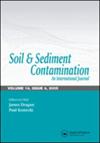Sorption and desorption of arsenic from sandy soils: Column studies
IF 1.5
4区 环境科学与生态学
Q4 ENVIRONMENTAL SCIENCES
引用次数: 25
Abstract
Rate‐limited sorption/desorption can have a profound effect upon the transport of sorbing contaminants. Numerical and analytical models used to predict chemical movement through the subsurface rarely incorporate the effects of nonlinear sorption and desorption kinetics, resulting in potentially large overestimates of mass extractability. Mass transfer characteristics of arsenic‐contaminated soils at the site of a former arsenical herbicide manufacturer in Houston, Texas, were examined in the laboratory using soil columns. Unaffected soils comprised of silty sands to coarse sands were collected from the uppermost aquifer. Two soil columns were loaded with a known mass of mixed organic and inorganic forms of arsenic resident in site ground water. A third control column was prepared with dry 20 × 30 mesh ASTM silica sand. Leachate samples were collected from each void volume until arsenic breakthrough was achieved. The dynamic test applied a continuing head of water, operating in an upflow mode through 4‐in....砂土对砷的吸附和解吸:柱研究
速率限制的吸附/解吸对被吸附污染物的输送有深远的影响。用于预测地下化学运动的数值和分析模型很少考虑非线性吸附和解吸动力学的影响,导致对质量可萃取性的潜在高估。在实验室中,利用土壤柱研究了德克萨斯州休斯顿一家原砷除草剂生产基地砷污染土壤的传质特性。未受影响的土壤由粉砂到粗砂组成,从最上层含水层收集。两个土壤柱装载了已知质量的混合有机和无机形式的砷,这些砷存在于现场地下水中。第三根对照柱用20 × 30目干燥的ASTM硅砂制备。从每个空隙体积中收集渗滤液样本,直到砷突破为止。动态测试采用连续的水头,通过4‐in....以上涌模式运行
本文章由计算机程序翻译,如有差异,请以英文原文为准。
求助全文
约1分钟内获得全文
求助全文
来源期刊

Soil & Sediment Contamination
环境科学-环境科学
CiteScore
4.20
自引率
10.00%
发文量
53
审稿时长
2.2 months
期刊介绍:
When it comes to assessing and mitigating contaminated soils and sediments, there is no substitute for having the very latest tools, techniques and methodologies at your fingertips to help you deal with these issues efficiently and cost-effectively.
This is just the kind of essential expertise you’ll only find in Soil and Sediment Contamination . This internationally, peer-reviewed publication focuses on soil and sediment contamination from:
-Sludges-
Petroleum-
Petrochemicals-
Chlorinated hydrocarbons-
Pesticides-
Lead and other heavy metals.
Get detailed descriptions of all the latest and most efficient offsite and in situ remediation techniques, strategies for assessing health effects and hazards, and tips for dealing with everyday regulatory and legal issues. With the state-of-the-art tools that Soil and Sediment Contamination provides, you can successfully assess, mitigate, and solve both rural and urban soil contamination problems as efficiently and economically as possible.
 求助内容:
求助内容: 应助结果提醒方式:
应助结果提醒方式:


